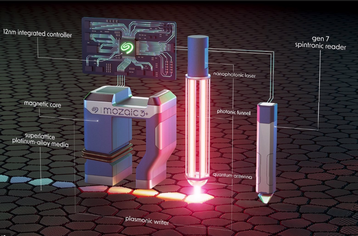Seagate Technology is shipping 30TB hard drives based on its heat-assisted magnetic recording (HAMR) technology, and expects to ramp up to full production by the end of March.
The Mozaic 3+ platform will offer areal densities of more than 3 terabytes (TB) per platter, allowing Seagate to deliver 30TB products in its Exos family of hard drives this quarter.
Hyperscale customers already have evaluation units and are planning to adopt it wholesale when it is fully available, the company told DCD.
"We are shipping units, and expect to get major customers qualified by this quarter," said BS Teh, chief commercial officer, Seagate Technologies. "And we hope to ship as many as a million by the end of the year."
The Mozaic HAMR technology uses a medium that can be magnetized in much smaller domains than conventional vertical recording media, but which has to be heated to become writable. This means that Seagate has had to develop HDD read-write heads with tiny lasers that can heat the platter precisely where bits are to be written.
Teh said the new drives have double the capacity of storage systems using conventional 16TB perpendicular magnetic recording (PMR) drives, and this can be doubled again over the next four years. The company is projecting 4TB platters in the next couple of years, with 5TB coming shortly thereafter, and 6TB out beyond the current roadmap.
The new drives use roughly the same material components as existing PMR drives, Teh told DCD, so the overall cost and environmental footprint per TB of storage will be lower. The new drives will consume 40 percent less power per TB, and embody 55 percent less carbon than 16TB PMR drives, said Teh.
The new drives require media with much smaller magnetic grains, in an iron-platinum superlattice structure, which increases the magnetic coercivity of the media. Because the HAMR medium requires heating, Seagate has developed a nanophotonic laser, which produces an infinitesimal heat spot on the surface to write the data reliably.
The whole thing is controlled by a Seagate-developed controller system on a 12nm technology chip.
Seagate has promised HAMR drives for some years, showing a 16TB prototype in 2018, but this is the first time the technology has reached the market. Teh said that productizing HAMR has proven challenging, but the delay was actually more to do with developments in existing HDD technology.
"Existing technology continued better than we had planned," he said. The older technology continued to have legs, so we continued the lifecycle and pushed out the HAMR platform."
Another factor was that HDD capacity demand actually fell in the last couple of years, but is expected to surge now as AI applications begin to be rolled out. The capacity demands of AI training are well known, but AI inference systems are expected to shift the demand to even more storage, he said.
“Seagate is the world’s only hard drive manufacturer with the areal density capability to get to 3TB per platter and with 5TB on the horizon,” said Dave Mosley, Seagate’s CEO. “As AI use cases put a premium on raw data sets, more companies are going to need to store all the data they can. To accommodate the resulting masses of data, areal density matters more than ever.”


